Contents
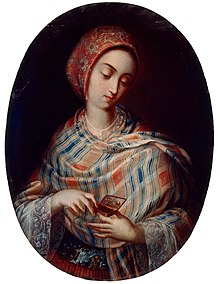
A rebozo is a long flat garment, very similar to a shawl, worn mostly by women in Mexico. It can be worn in various ways, usually folded or wrapped around the head and/or upper body to shade from the sun, provide warmth and as an accessory to an outfit. It is also used to carry babies and large bundles, especially among indigenous women. The origin of the garment is unclear, but Indigenous women of Mesoamerica were the primary weavers of the first rebozos, often crafted with body-tensioned or back-strap "otate" looms. Spaniards used it in religious situations to conceal the bare bodies of indigenous women. Rebozos were quickly influenced by the fringed shawls of the Philippines and Spanish mantillas as a result of colonization. Traditional versions of the garment show indigenous, European and Asian influences. Traditional rebozos are handwoven from cotton, wool, silk and rayon in various lengths but all have some kind of pattern (usually from the ikat method of dyeing) and have fringe, which can be fingerwoven into complicated designs. The garment is considered to be part of Mexican identity. It has been prominently worn by women such as Frida Kahlo, actress María Félix and former Mexican first lady Margarita Zavala and still popular in rural areas of the country. However, its use has diminished in urban areas.
Description and use of garment

A rebozo is a long straight piece of cloth which looks like a cross between a scarf and a shawl. Like ponchos, huipils and sarapes they are classic Mexican garments made of straight, mostly uncut cloth, but rebozos have their own characteristics.[1] It is classically a woman's garment, traditionally hand woven, distinguished by complicated fingerwoven fringes called rapacejos.[2][3] The wearing of the rebozo is said to make the movement of a woman more graceful.[4] The wearing of a rebozo by many women is a sign of Mexican heritage, and for that reason, sales of the garment can double before Mexican Independence Day on September 16.[5][6] Because of the nature of the garment, especially the fringes, they should be hand washed. The dye may or may not be colorfast so mild soap should be used.[7]

While all rebozos are rectangular woven cloth with fringes, there is significant variation within these constraints. There are three classes of rebozos. Traditional ones have a design created with the ikat dyeing technique and come in various set patterns. Regional rebozos are more colorful and their origins can be identified, especially those from Oaxaca, Chiapas and Guerrero. Contemporary rebozos experiment with non-traditional fibres and designs.[8] Sizes vary with lengths anywhere from 1.5 to about 3.5 meters long.[2][9][10] Most Mexican rebozos are made from cotton, wool, silk or rayon.[9][11] The type of fibre used is the main factor in determining a price of a piece which can vary from a couple hundred pesos to thousands of pesos, with fine pure silk pieces being the most expensive.[9][12] The finest silk rebozos can be passed through a wedding ring.[9][13]
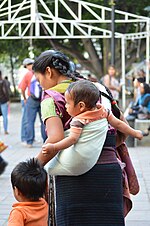
Rebozo colors and patterns vary widely and traditional designs can usually identify where it was made.[14] For example, a tightly woven black and indigo version is identified with the mountain areas of the state of Michoacán.[13] Designs are generally classified as "classic" and "indigenous." Classic rebozos come in various colors with designs based on the prehispanic art of plumaría, or creating images with feathers. Some of these have their fringes knotted to form images of animals and stares. However, almost all are created with the ikat technique.[11][13] The most famous classic rebozo style is called "de bolitas" whose name comes from little knots of string tied onto groups of threads used in its production.[15] Among indigenous groups designs and colors almost always indicate with group the woman belongs.[7] While most rebozos use more than one color, monochrome versions are called "chalinas."[16]

Rebozos have two main functions, that of a garment and that as a carrying aid. As a garment, it can be an indispensable part of the wardrobe of many mestizo and indigenous women, especially those who live in rural areas.[13][17] As a shawl, it can provide warmth (especially the thicker and wool ones), worn on the head to block the sun as well as for modesty, especially in church.[2][7] For city and upper-class women who use them, they can be worn inside the home but are most often used as an accessory to an outfit, especially on certain occasions.[7][17] As a carrying aid, it can be tied around the head or shoulders most often to carry small children and large bundles, mostly commonly among indigenous women.[2][9] The rebozo has even figured into Mexican traditional medicine. It has been used as a tourniquet, as support for a woman in later pregnancy, as an aid to a woman in labor, supporting her allowing for rhythmic movements and positioning with aim of making childbirth easier. It can also be used to alleviate headaches by tying it tightly around the head.[18] Other uses for the rebozo have been in indigenous traditional dances and even as a shroud.[13][17] One modern and innovative way to wear it has been to twist it around the upper body and fastened to make a kind of blouse or top.[12]
History
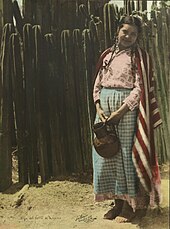
The name comes from Spanish, from the verb that means to cover or envelope oneself.[19] However, there have been indigenous names for it as well, such as "ciua nequealtlapacholoni" in colonial-era Nahuatl, which means "that which touches a woman or something like her," "mini-mahua" among the Otomi and in the Nahuatl of Hueyapan, Morelos, it is called "cenzotl" from a phrase that means "cloth of a thousand colors."[19]
The origin of the rebozo is not known, but probably had its beginnings in the very early colonial period.[11][16] The first mention and description of the garment in written records is in 1572 by Friar Diego Duran, according to research done by Ruth D. Lechuga.[11] The rebozo itself shows various influences, which probably come from the various cultures that had contact at that time.[11][13]
There are various indigenous garments that share physical characteristics with the rebozo. They include the ayate, a rough cloth of maguey fibre used to carry cargo, the mamatl, which is a cotton cloth also used to carry objects and which often had a decorative border, and the tilma (used for carrying and as a garment), a cloth best known from the one Juan Diego wore and which bears the image of Our Lady of Guadalupe.[11][20] There are chronicles that say that la Malinche carried a cloth called a "Manta del sol" or "Sun Cloth", which was not just used to protect from the sun but also to denote status as decoration.[3] However, prehispanic clothing and other cloths did not have woven fringes.[14] The main European influence is most likely the Spanish mantilla, although a southern Spanish garment called a rebociño (introduced to the area by the Moors) may have also played a part. Later influences came from the Filipino alampay (Spanish pañuelo) at the start of trade from the Manila galleons. The 19th century mantón de Manila, also based on the alampay, was also influential in the development of the characteristic fringes.[21][3][11]

Its origin was most likely among the lower, mestizo classes in the early colonial period, being most prominent among them first.[7][16] The most traditional rebozos show coloring and designs from the colonial period and mestizo women probably wore them to distinguish themselves from indigenous women but could not afford Spanish finery.[11][13] In 1625, Thomas Gage noted that blacks and mixed race people in Mexico wore wide strips of clothes on their head instead of the Spanish mantilla.[11] In the colonial period how it was worn distinguished married women from single. Married women wore it loose covering the top of the head down over the back. Single women would wrap it tighter, allowing more of the back to be seen.[9] These garment were initially made of cotton but by later in the colonial period, they were also made of wool and silk.[19] Their use eventually spread into indigenous communities becoming an integral part of many women's attire and culture. For example, an Otomi woman used to dip a point of her rebozo into water to indicate that she was thinking of her betrothed or husband.[17][22] One important use for the garment in colonial times to the 19th century was for women to cover their heads in church.[8] After its initial development in Mexico, its use spread south into Central America and even as far as Ecuador.[15]
The rebozo was in common use among the middle and lower classes by the 18th century, with the kind of fibre used to weave it distinguishing the two. The garment was in common use among women by the 18th century. At that time the Count of Revillagigedo noted that it was worn by all women except nuns and those of the uppermost classes.[7][11] The two most common fibres were cotton and the more expensive cotton/silk or silk. Sizes and designs varied but those made with the ikat dyeing technique became dominant.[11] In some parts of Mexico, a woman was given a rebozo by a man as a way to propose matrimony instead of a ring.[9] The finest rebozos included ornate embroidery including silver and gold thread. One fashion of that century was to embroider country scenes.[11][13]
In 1886, a synthetic silk called rayon was created in France. The use of this cheaper thread made decorative rebozos more affordable.[6] Its use as an identifying marker of Mexican identity began at this time as well with even the Empress Carlota wearing it on various formal occasions, especially while at her country home in Cuernavaca.[3] By the end of the 19th century, the garment had become indispensable and their making an important handcraft.[11]
Its symbolic function continued into the Mexican Revolution, and item associated with rebel women called "Adelitas," who carried both babies and weapons wrapped inside past federal checkpoints.[23][7][24] During this time, the rebozo was also often used as a shroud for the dead. Much of the world's familiarity with the rebozo comes from later cinematic depictions of Adelitas, but it also accentuated the garment's use with indigenous women, poverty and low socioeconomic station.[2]
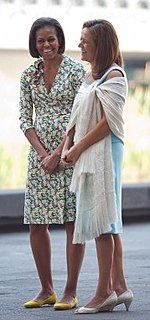
Today, the rebozo can be found in all parts of Mexico and just about all women in the country own at least one regardless of socioeconomic class.[22][25][26] In many villages, women are still born in them, grow up with them, get married with them and are buried in them.[27] It is still commonly worn in church by rural women.[16] During the 20th century, the rebozo came to be seen as both a sign of modesty/tradition and of revolution including in some communities in the United States. For women of the Chicano movement, it represented the "complete woman" as both feminine and strong, ready to fight for "the Cause."[28] Personalities which have prominently worn rebozos include María Félix, Frida Kahlo, Lila Downs and model Luly Jáuregui as well as former Mexican First Lady Margarita Zavala who was noted for wearing the garment at state functions.[2][29] The rebozo has appeared in popular culture and media as well as literature.[15] During the Golden Age of Mexican cinema the garment appeared in many movies, including one named El Rebozo de Soledad (Soledad's Rebozo).[1] A de bolita patterned rebozo is mentioned in one of Francisco Gabilondo Soler’s famous children's songs.[17] The character of la India María, played by renowned female comedian María Elena Velasco, is very characterized by her rebozo.
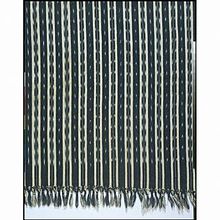
However, despite its status as a national symbol, its use has diminished among women, especially those in cities.[11] One reason for this is that the garment is associated with indigenous groups and poverty and another is that the fine handwoven rebozos, especially of silk are very expensive because of the skilled labor required.[9][22] (tenancingohis) Many of the most expensive rebozos are no longer made in many parts of the country, with the exceptions of Santa María del Río and San Luis Potosí City.[5] The number of weavers of all types of rebozos have diminished. For example, there are only fifty in the entire state of Jalisco, almost all concentrated in a few municipalities such as Sayula and Tuxpan.[1]
Efforts have been made to preserve and promote the use of the rebozo in various ways. In 1953, the Escuela de Rebozo (Rebozo School) was established to teach the weaving techniques used. In 2002 the school won the Premio Nacional de Artes y Tradiciones Populares. Other institutions dedicated to the craft are Museo de Rebozo in la Piedad, Michoacan, the Tejedoras de la Tercera Edad, run by the Secretariat of Culture in Acatlán, Veracruz and the Taller de Rebocería in the Casa de la Cultura in Tenancingo, State of Mexico.[22] Since the 1940s, various techniques have been used to modernize the design of the garment, including the use of sequins.[11] Some modern Mexican fashion designers like Lydia Lavín and Monserrat Messeguer have designed modern versions of the garment, using new fabrics and international patterns, such as those from the Oriente and Africa.[30]
Rebozos have been the center of museum, cultural and fashion events in Mexico.[25] Various fairs and festivals dedicated to the garment are held in places such as Matamoros, Tamaulipas,[31] Jiquilpan,[4] Tenancingo,[32] and Zapopan.[33] The first Concurso Nacional del Rebozo (National Rebozo Contest) was held in San Luis Potosí in 2004.[1] The Universidad del Valle de Atemajac, Campus La Piedad created a video called "El Arte del Rebozo" to promote the garment both online and at international events.[34] The university held a conference with the same name in 2012.[24] For the 100th anniversary celebrations of the Mexican Revolution in Coyoacán, Mexico City, the rebozo was featured prominently.[35] The Museo Nacional de Culturas Populares in Mexico City held an event called "Tápame con tu rebozo" in 2012, to promote the use and sale of the garment.[14] Exhibitions of rebozos have also been held in the Southwestern United States with the first Festival del Rebozo in the country held in New Mexico,[8] exhibitions at the University of Texas at Brownsville at the Austrey Museum in Los Angeles[33] and Fresno, California holds an annual Day of the Rebozo Festival.[27] There is also a museum dedicated to the garment in Guadalajara called La Casa del Rebozo. In addition to a collection of rebozos in many sizes, colors and textures, it offers conferences, classes, workshops and fashion shows to promote the garment.[2][8]
Production
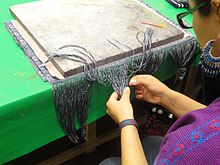
Mexico is the main producer and exporter of rebozos, but some are also produced in Spain and Portugal.[15][36] Average time to make a traditionally woven rebozo is thirty to sixty days with anywhere fifteen to 200 different steps depending on how complicated the design is and the type of fibre being used.[13][22] For example, rebozos made of real silk take longer to weave. Those made of rayon have about 3,000 warp threads on average and those made of real silk have about 3,800.[16]
The dyeing process is done before weaving, with the most common technique being the ikat method, sometimes called "amarrado" (lit. stingy)[17] In the most traditional work, thread is dyed with natural colors, with colors such as black, blue, red, purple and green but synthetic dyes are now often used.[7][10][37] The patterns of the garment are determined by a sequence of colors dyed into the thread, with color changes made similar to tie-dyeing. Groups of threads are tied together tightly at intervals so that the dye cannot enter some areas. After dyeing, the knots are cut off.[10][37] The weaving begins by cutting the warp threads to the length of the final product. The number of threads determines the width.[10] They are woven on both backstrap looms and European style looms.[7] The groups of warp threads are then placed on the loom in order to work out the design that the body of the cloth will have.[22] After weaving, the last rows of the weft are finger weaved to secure them, which is complicated and meticulous work, often done by women specialized in this.[17] Isabel Rivera and Julia Sánches of Santa María have won national and international awards for their work, with the ability to weave letters into the fringes of rebozos.[10][22] In some areas, after they are finished, rebozos are "smoked" with rosemary branches or are stored with apples or quince in order to make them smell good.[7]
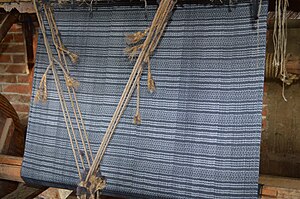
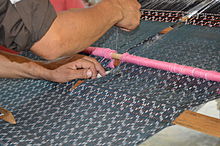
There are a number of locations in Mexico which produce traditional rebozos including, Zamora, Ahuirán, Turícuaro, Angahuan, Santa Cruz, Tocuaro, Zitácuaro, Cuanajo, Arocutín and Tangancícuaro in Michoacán,[7][25] Moroleón and Uriangato in Guanajuato,[7] the Altos de Chiapas region, Xochistlahuaca in Guerrero, the Sierra Norte de Puebla, San Pedro Cajonos, Pinotepa de Don Luis, Yalalag, and Santa María Tlahuitoltepec in Oaxaca[14] as well as the Cooperativa Textil Artesanal in the city of Oaxaca[5] and Chiautempan, Tlaxcala,[22] However, there are several important locations whose work are featured in important collections such as that of the Rockefeller family. These include Santa María del Río, Tenancingo and La Piedad.[13]
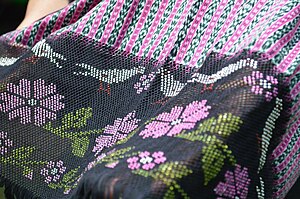
Santa María del Río is a small rural town in the state of San Luis Potosí, containing country homes for the well-to-do in the city of San Luis Potosí. The entrance arch of the town states "Santa María del Río, cuna del rebozo" (Santa María del Río, cradle of the rebozo).[17] Even the local baseball team is named after rebozo weavers, called the "Reboceros."[32] It is known for its production of finely woven rebozos especially in silk and rayon, with cotton ones made as well.[10] Weaving was introduced to the area shortly after the conquest and gained fame by the 17th century.[19] Silk production was introduced originally in Oaxaca by the Dominicans. Despite prohibitions, Junípero Serra introduced their cultivation into the region in the 18th century, with silk production and weaving becoming widespread by the late 19th century into the 20th.[6][17] The variety of silk traditionally used in these rebozos is called "catiteo."[6] After the Mexican Revolution, the haciendas producing silk were broken up and many weavers turned to rayon and very few are still made with pure silk.[17] Their production is done by families, but only by the women, with a number winning national awards for their work.[10] In Santa María the use of various browns is a distinguishing characteristic of the region. Other common colors are black, blue, red, purple and green along occasional white threads which appear as flecks in the final product. There are a number of traditional color combinations and designs with names such as calabrote, Rosita, rosarito, culebrilla calado and more.[10][17] Santa Maria hosts a Feria del Rebozo in August and is home to the Escuela de Rebozo (Rebozo School) and a cooperative called the Taller Escuela de Rebocería.[16]
The making of cotton rebozos is important in Tenancingo and an image of the garment appears in the municipality's seal.[38] Tenancingo's rebozos come in a wide variety of prices from 400 to 4,000 pesos, depending on the quality of the cotton, the complexity of the design and the thread count. The craft was developed in Tenancingo by the 17th century and reached its peak during the 19th century. The creation of the garment remains important both culturally and economically, with the work here recognized at the national and international levels.[39] One of the town's most important weavers is Evaristo Borboa.[40]
The mountain areas of Michoacán have been noted for an indigo blue variety of rebozo, known as the Michoacán or Tarasco rebozo. In the 1930s and 1940s, the city of La Piedad, Michoacán became a major producer of rebozos of both natural and synthetic fibres.[20] In 1946 the Unión de Reboceros de La Piedad was formed and in 1958, the Sindicato Único de Reboceros de La Piedad.[37]
See also
- Aguayo, a similar piece of cloth used in the Andes
- Dupatta, a similar piece of cloth used in South Asia
- Pañuelo, a similar traditional clothing from the Philippines
- Manila shawl, a 19th century shawl derived from the Philippine pañuelo
- Mantilla, a similar-looking women's Spanish head-dress made of cloth, similar to a veil. Maybe a case of exchange or convergence
References
- ^ a b c d Gonzalez, Enrique (July 19, 2004). "Trabajan por rescate del rebozo" [Working to rescue the rebozo]. Mural (in Spanish). Guadalajara. p. 8.
- ^ a b c d e f g "Las Adelitas en el siglo XXI" [The "Adelitas" of the 21st century]. El Informador (in Spanish). Guadalajara. September 19, 2010. Retrieved December 30, 2014.
- ^ a b c d Wilfrido Ávila García (June 1, 2008). "El rebozo mexicano" [The Mexican rebozo]. El Sol de Cuernavaca (in Spanish). Cuernavaca. Retrieved January 15, 2013.
- ^ a b José de Jesús Ceja (August 1, 2012). "Continúa el 3er. Festival del Rebozo en Jiquilpan" [3rd Rebozo festival in Jiquilpan continues]. El Sol de Morelia (in Spanish). Morelia. Retrieved January 15, 2013.
- ^ a b c Rosalba Guzman Ayala (July 9, 2010). "Duplican por fiestas patrias la venta de rebozos" [Sales of rebozoes double for Independence Day]. Periódico AM (in Spanish). Oaxaca. Archived from the original on February 19, 2013. Retrieved January 15, 2013.
- ^ a b c d "Materias Primas" [Raw materials] (in Spanish). Mexico: Municipality of Santa María del Río. Archived from the original on October 30, 2013. Retrieved January 15, 2013.
- ^ a b c d e f g h i j k l Huerta, Rocío (November 19, 2011). "El rebozo una tradición con historia entretejida" [The rebozo, a tradition with history]. Periódico Correo (in Spanish). Guanajuato. Archived from the original on February 19, 2013. Retrieved January 15, 2013.
- ^ a b c d Julia Marisol Hernandez (June 13, 2012). "Únete al Festival del Rebozo" [Join the Rebozo Festival]. El Occidental (in Spanish). Guadalajara. Retrieved January 15, 2013.
- ^ a b c d e f g h Herrera, Raúl (March 15, 2011). "El Rebozo: tradición que se está perdiendo" [The Mexican rebozo]. El Sol de Parral (in Spanish). Parral, Chihuahua. Retrieved January 15, 2013.
- ^ a b c d e f g h "Proceso de Elaboración del Rebozo" [Process of creating the rebozo] (in Spanish). Mexico: Municipality of Santa María del Río. Archived from the original on October 31, 2013. Retrieved January 15, 2013.
- ^ a b c d e f g h i j k l m n o "El rebozo". Artes e Historia magazine (in Spanish). Mexico City. Archived from the original on January 9, 2013. Retrieved January 15, 2013.
- ^ a b Schultz, Alex K. W. (August 20, 2007). "Community celebrates Day of the Rebozo Festival: Tradition: Shawl can be used for many purposes". McClatchy - Tribune Business News. Washington. p. 1.
- ^ a b c d e f g h i j Marion Rockefeller, Nelson A; Roberts, Ann R (2010). Folk Treasures of Mexico : The Nelson A. Rockefeller Collection. Houston, TX, USA: Arte Público Press. pp. 66–67. ISBN 9780810911826.
- ^ a b c d "Exhiben la magia del rebozo mexicano" [Exhibit the magic of the Mexican rebozo]. El Universal (in Spanish). Mexico City. September 13, 2012. Retrieved January 15, 2013.
- ^ a b c d Guzman, Alejandro; Oralia Gonzalez de Ceron (September 2, 2000). "El rebozo una prenda 100% mexicana" [The rebozo, a 100% Mexican garment]. Reforma (in Spanish). Mexico City. p. 11.
- ^ a b c d e f Armendariz, Lorenzo (August 15, 1999). "Santa Maria Del Rio, San Luis Potosi: La tierra del rebozo" [Santa María del Río, San Luis Potosí: The land of the rebozo]. Reforma (in Spanish). Mexico City. p. 16.
- ^ a b c d e f g h i j k Paloma Quijano Castelló (13 August 2010). "Los rebozos de Santa María del Río (San Luis Potosí)" [The rebozos of Santa María del Río (San Luis Potosí)]. Mexico Desconocido magazine (in Spanish). Mexico City. Retrieved January 15, 2013.
- ^ Pérez, Rebeca (November 20, 2009). "Revalora el rebozo medicina tradicional" [Revaluing the rebozo in traditional medicine]. Mural (in Spanish). Guadalajara. p. 8.
- ^ a b c d "Historia Casa de Artesano Santa María de Río" [History Casa de Artesano Santa María del Río] (in Spanish). Mexico: Municipality of Santa María del Río. Archived from the original on October 31, 2013. Retrieved January 15, 2013.
- ^ a b Ernesto López Servín (June 22, 2012). "La historia del rebozo piedadense" [History of the La Piedad rebozo]. El Sol de Morelía (in Spanish). Morelia. Retrieved January 15, 2013.
- ^ Schevill, Margot Blum; Berlo, Janet Catherine; Dwyer, Edward B., eds. (2010). Textile Traditions of Mesoamerica and the Andes: An Anthology. University of Texas Press. p. 312. ISBN 9780292787612.
- ^ a b c d e f g h Juan Manuel Zaragoza Rea (14 July 2010). "El rebozo. Un accesorio potosino elegante y único" [The rebozo, an elegant and unique accessory from San Luis Potosí]. Mexico Desconocido magazine (in Spanish). Mexico City. Retrieved January 15, 2013.
- ^ "A History of the Iconic Mexican Rebozo and How to Style It for Modern". MADEINMEXI.CO. Retrieved 2021-01-01.
- ^ a b Roberto Arellano Diaz (June 13, 2012). "¡El arte de usar rebozo!" [The art of wearing the rebozo!]. Periódico AM (in Spanish). Oaxaca. Archived from the original on February 19, 2013. Retrieved January 15, 2013.
- ^ a b c García, Olivia (July 31, 2011). "Resaltan en la Ciénega historia y tradición del rebozo michoacano" [History and tradition of the rebozo highlighted in La Ciénega]. El Cambio de Michoacán (in Spanish). Morelia. Archived from the original on November 24, 2015. Retrieved January 15, 2013.
- ^ Félix, Marcela (December 12, 2008). "Quiere modernizar el rebozo" [They want to modernize the rebozo]. Mural (in Spanish). Guadalajara. p. 12.
- ^ a b Villicana, Sarah Elizabeth (July 12, 2007). "Wrapped in history: Shawl: 'Day of the Rebozo' festival set for Aug. 18 in Porterville". McClatchy - Tribune Business News. Washington. p. 1.
- ^ Montejano, David (2010). Quixote's Soldiers : A Local History of the Chicano Movement, 1966-1981. Austin, TX, USA: University of Texas Press. pp. 173–174. ISBN 978-0292722903.
- ^ Ana Paulina Valencia (29 November 2012). "Los 3 rebozos más chic de Margarita Zavala" [The three most chic rebozos of Margarita Zavala]. Quien magazine (in Spanish). Mexico City. Retrieved January 15, 2013.
- ^ Olvera, Delgado (September 21, 2012). "El rebozo y la fusión de culturas" [The rebozo and cultural fusioin]. El Sol de Parral (in Spanish). Mexico City. Retrieved January 15, 2013.
- ^ "Traen a Matamoros el Festival del Rebozo" [Festival of the Rebozo brought to Matamoros] (in Spanish). Tamaulipas: Government of Matamoros. February 20, 2012. Archived from the original on February 21, 2013. Retrieved January 15, 2013.
- ^ a b Angel Bernal Davila (September 15, 2010). "Expo Feria del Rebozo en Tenancingo" [Exhibition/Fair of the Rebozo in Tenancingo]. El Informador (in Spanish). Guadalajara. Archived from the original on February 21, 2013.
- ^ a b "Colorido desfile de rebozos a beneficio del adulto mayor en Zapopan" [Colorful parade of rebozos to benefit seniors in Zapopan]. El Periodico de Mexico (in Spanish). Mexico City. June 10, 2006. Retrieved January 15, 2013.
- ^ Ruiz, Eduardo (July 23, 2012). "Se busca promover el rebozo piedadense en el extranjero" [Looking to promote the La Piedad rebozo abroad]. La Vox de Michoacán (in Spanish). Morelia. Retrieved January 15, 2013.[permanent dead link]
- ^ Del Valle, Óscar (November 21, 2010). "Destaca Coyoacán tradición del rebozo" [The tradition of the rebozo stands out in Coyoacán]. Reforma (in Spanish). Mexico City. p. 2.
- ^ Rodolfo Valadez Luviano (September 19, 2010). "Reivindican el uso del rebozo" [Revindicating the use of the rebozo]. La Jornada (in Spanish). Mexico City. Archived from the original on 2014-09-11. Retrieved January 15, 2013.
- ^ a b c "Rebozos" (in Spanish). Mexico: State of Michoacán. Archived from the original on 2013-02-03. Retrieved January 15, 2013.
- ^ "Historia" [History] (in Spanish). State of Mexico: Government of Tenancingo. Retrieved January 15, 2013.
- ^ De La Peña Virchez, Rosa Guadalupe; Nava Sánchez, Karla Josefina (November 12, 2011). "Exposición itinerante del rebozo, como estrategia para la revalorización del patrimonio artesanal en el municipio de Tenancingo, Estado de México" [Exhibitions of the rebozo as a strategy for the revaluing of the artisanal heritage in the municipality of Tenancingo, State of Mexico] (PDF). Revista Digital de Gestión Cultural (in Spanish). 1 (2). ISSN 2007-3321. Retrieved January 15, 2013.
- ^ "Tenancingo, la ciudad de los rebozos (Estado de México)" [Tenancingo, the city of Rebozos (State of Mexico)]. Mexico Desconocido magazines (in Spanish). Mexico City. 13 August 2010. Retrieved January 15, 2013.
External links
- Hand-colored photographs by Luis Márquez (photographer) of people wearing or using rebozos in the 1930s at the University of Houston Digital Library. Photo 1Photo 2Photo 3. Photo 4

